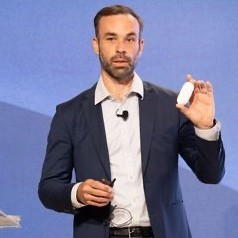- Video Library
- Leo Trautwein Presents Know Labs at LSI USA '24
Leo Trautwein Presents Know Labs at LSI USA '24

Leo Trautwein
Accomplished executive with over 20 years of experience driving growth and profitability across consumer goods, automotive, and medical technology industries, having managed multiple P&Ls and transformative initiatives for Fortune 500 and small to medium-sized businesses.
• As Chief Commercial Officer at Know Labs (NYSE: KNW), leads go-to-market strategy for the company's innovative non-invasive glucose monitoring device. Responsible for partnerships, regulatory approvals, manufacturing, operations, and commercialization of a medical device that can transform diabetes care.
• As Head of E-commerce at Jarden (NYSE: JAH) and Vista Outdoor (NYSE: VSTO), two multi-billion consumer goods companies, delivered double-digit growth and improved profitability through data-driven commerce initiatives. Proven track record of scaling e-commerce businesses and developing high-impact strategies.
• At Rivian Automotive, established the Mobility Operations Division for the electric vehicle startup. Designed the operations from the ground up as Rivian prepared to launch its debut models with backing from major institutional investors, such as Amazon, Ford, and Sumitomo.
• Early career as a strategy consultant advising Fortune 500 companies on growth strategies, M&A, new market entry, cost reduction, and strategic partnerships. Advised clients primarily focused on consumer goods, automotive, and utility industries.
• Holds an MBA from the Tuck School of Business at Dartmouth and a Bachelor of Mechanical Engineering from the University of Sao Paulo in Brazil. Has also co-founded a dermatology medical practice and a medical scrubs business.
Leo Trautwein
Accomplished executive with over 20 years of experience driving growth and profitability across consumer goods, automotive, and medical technology industries, having managed multiple P&Ls and transformative initiatives for Fortune 500 and small to medium-sized businesses.
• As Chief Commercial Officer at Know Labs (NYSE: KNW), leads go-to-market strategy for the company's innovative non-invasive glucose monitoring device. Responsible for partnerships, regulatory approvals, manufacturing, operations, and commercialization of a medical device that can transform diabetes care.
• As Head of E-commerce at Jarden (NYSE: JAH) and Vista Outdoor (NYSE: VSTO), two multi-billion consumer goods companies, delivered double-digit growth and improved profitability through data-driven commerce initiatives. Proven track record of scaling e-commerce businesses and developing high-impact strategies.
• At Rivian Automotive, established the Mobility Operations Division for the electric vehicle startup. Designed the operations from the ground up as Rivian prepared to launch its debut models with backing from major institutional investors, such as Amazon, Ford, and Sumitomo.
• Early career as a strategy consultant advising Fortune 500 companies on growth strategies, M&A, new market entry, cost reduction, and strategic partnerships. Advised clients primarily focused on consumer goods, automotive, and utility industries.
• Holds an MBA from the Tuck School of Business at Dartmouth and a Bachelor of Mechanical Engineering from the University of Sao Paulo in Brazil. Has also co-founded a dermatology medical practice and a medical scrubs business.

17011 Beach Blvd, Suite 500 Huntington Beach, CA 92647
714-847-3540© 2025 Life Science Intelligence, Inc., All Rights Reserved. | Privacy Policy







